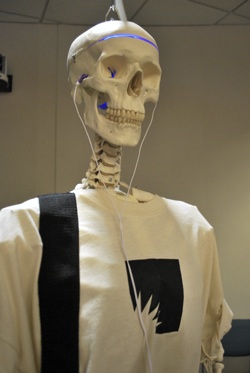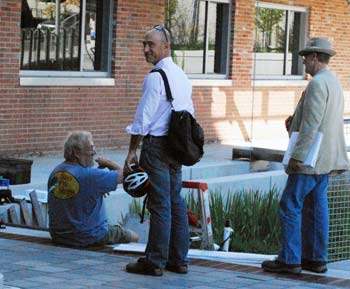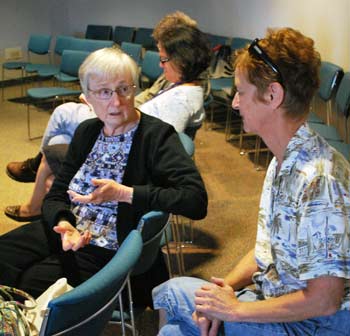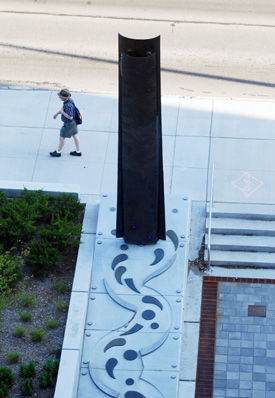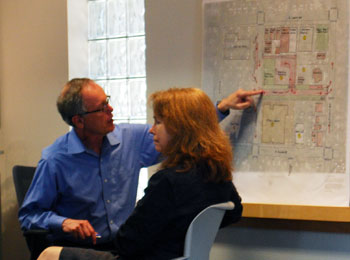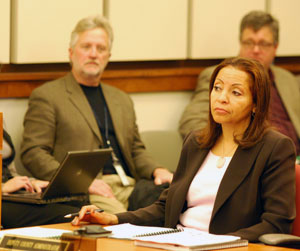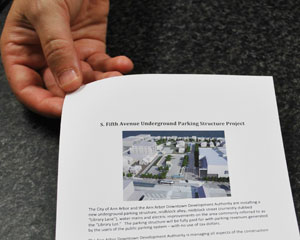Redesign Planned for Library “Front Porch”
Ann Arbor District Library board meeting (Feb. 17, 2014): Work on a significant redesign to the front entrance of the downtown Ann Arbor library is moving forward, following action this month by the AADL board.
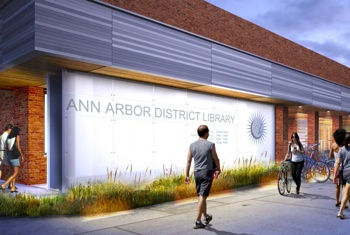
Rendering of proposed new entry at downtown Ann Arbor library, located at 343 S. Fifth Ave. (Image by InForm Studio.)
A vote to continue with the project followed a presentation by Cory Lavigne of InForm Studio, the architecture firm that previously designed AADL’s Traverwood branch. A final design will likely be brought forward for approval at the board’s April 21 meeting, after a public forum in mid-March. Update: The forum is scheduled for Thursday, March 13 at 5:30 p.m. at the downtown building.
The entrance would continue to be oriented to South Fifth Avenue, with new doors into the building. The plan described by Lavigne includes replacing the existing teal strip that wraps around the front of the building – above the doors and windows – with a “concrete skin” panel. Wood paneling would be used in the ceiling of the outside walkway adjacent to the building. Sloping entry walkways would be located on the north side from the Library Lane parking structure and on the south side from William Street, with steps in front leading to South Fifth Avenue. Additional elements include landscaping, a bench, handrails and other features that visually link the library to the adjacent city-owned Library Lane.
The north side of the front facade, closest to Library Lane, would also include a large, translucent sign – made of glass or cast resin – that would be placed between existing brick columns, creating a screen along part of the walkway on that side of the building. The sign would be lit from the inside, with additional lighting along the walkway, to create a glowing effect.
It was that sign element that drew some criticism and concern at the board’s Feb. 17 meeting, primarily from Ed Surovell. He cautioned against creating any kind of shelter, saying it would simply be “an inviting nuisance.” AADL director Josie Parker acknowledged the concern, saying that she had discussed the issue with the library’s security staff as well. She told the board that no matter how the area is designed, security issues will always be a factor and would be handled as they are now, by security staff.
In other action at the board meeting, trustees approved revisions to more than a dozen sections of the AADL policy manual, and voted to create a new committee to help develop the next strategic plan, for 2015-2020. That planning effort had been the focus of a Feb. 3, 2014 board retreat.
Board members also got a brief update on the agreement for a new bike share program called ArborBike, which trustees will likely be asked to approve at their March 17 meeting. It relates to a bike station that will be located on the northern end of the downtown library’s property.
During her director’s report, Josie Parker told the board that the downtown library will be a site for the Living Lab Initiative, a project funded by the National Science Foundation. AADL will be the first public library to be involved in this project, and researchers will be working in the youth department through the end of September.
The board also heard from two people during public commentary: Changming Fan of TiniLite World Inc., who expressed interest in working with the library; and Jamie Vander Broek, a University of Michigan librarian and homeowner who described several reasons why she appreciated AADL. She concluded her remarks by saying: “I love paying my taxes for this library.” [Full Story]




